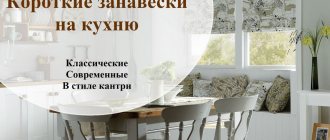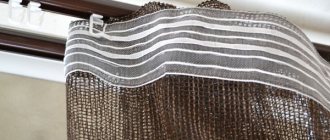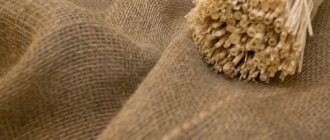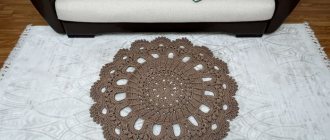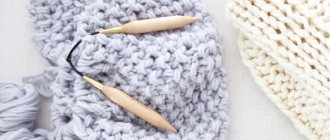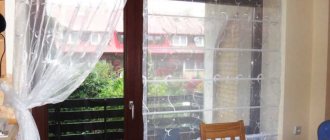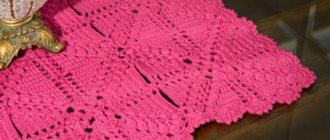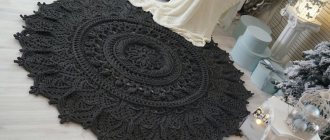Any person wants warmth, joy and comfort to reign in his home - which is why many of us strive to fill the interior with handmade items. It is these things that keep a piece of the soul of their creator and become especially dear to us and our loved ones.
The idea of crocheted curtains is by no means new - our great-grandmothers created incredible hand-made masterpieces, many of which were subsequently carefully preserved and passed on from generation to generation.
Knitted curtains are a triumph of the painstaking and long work of the needlewoman
In the modern world, buying fabric for curtains or even a completely finished product is not a problem. In any locality there are countless home textile stores.
You can also use the services of an atelier and order custom-made curtains, but you must agree, how much more pleasant it will be to create a miracle thing yourself that has no analogues in the whole world!
Where to start knitting curtains
The advantage of knitting is that it does not require large expenses. For knitting you will need a set of hooks, yarn and various patterns. Hooks come in different sizes - sizes from No. 0.5 to No. 8. Its thickness should be two times thicker than the selected yarn. The material is not important; needlewomen choose based on ease of use.
Set of metal hooks
The yarn can be linen, cotton, wool, silk or synthetic. For knitted curtains, natural threads are chosen, so the finished curtains will hold their shape better and will not lose it longer. The number of balls depends on the size of the selected curtain. Very thin yarn will delay the work, and the ornament will be smaller. To roughly determine the size, it is better to knit a small, simple sample.
Curtains are crocheted according to ready-made patterns. They are patterns and ornaments in the form of signs. Symbols are shown in the photo below. Having mastered several patterns, you will be able to knit original models. Kitchen curtains are usually knitted from top to bottom. The work begins with a chain of air loops, the length of which is equal to the width of the future curtain.
Curtains are knitted either in a single fabric or sewn together from individual motifs, for example, a granny square pattern or small round elements. Round parts are knitted from the center, smoothly moving in a spiral.
Colored curtain
How to knit curtains on a door, diagram and instructions, examples
The history of using curtains for doorways is as old as the world. Initially, they were in demand in aristocratic houses. Of course, there was no goal to replace entrance or interior doors with curtains. Still, the main purpose of this element was decoration. Stylish curtains make the room more cozy and romantic.
Beautiful curtain for the doorway
Pattern for knitting curtains for a doorway
Also, with the help of canvases, you can zone the space, for example, make two small living rooms out of one large hall.
Some people prefer to attach curtains not to the doorway, but to the door itself. This is especially appropriate if the doors are glass.
Knitted curtain made of bright yarn on the kitchen door
It is important to note that door curtains also have a division into styles. There are classic, modern or country styles. Art Nouveau is characterized by non-trivial interior solutions, for example, curtains made of shells or buttons.
Making such a curtain is very simple if you have the right number of shells
But in the classic design there is a place for “hand made”. These can be curtains made by crochet or knitting, usually in discreet colors. Country style is characterized by the use of rough curtain fabric, and the colors can be different.
For a rustic style, a curtain with a rough burlap trim is suitable
For a classic style, you can knit interesting curtains. The best yarn option is melange with different inclusions. You can simply knit in stockinette stitch or garter stitch, since the entire emphasis will be on color and texture.
Important! The design style of the doorway must be combined with the interior elements and be consistent in a certain color scheme.
The pattern on the curtain should be repeated in other decorative elements
In the photo, the curtain for the door is made using the macrame technique. The color of the yarn is in harmony with the color of the door jambs, and on the wall there is decor made using the same technique.
Curtain knitting technology
When working with crochet, various techniques are used, which determine the decorative appearance of the knitted curtain. There are several well-known techniques:
- Sirloin. The fillet technique is based on alternating empty and filled cells, or air loops with columns. The curtain for the kitchen can be knitted in a single fabric or in separate motifs. This is the most popular technique that allows you to work without patterns. With its help, flowers, birds, landscapes are knitted;
- Bruges or Vologda lace. This is a canvas that combines striped braid, background mesh and decorative motifs. The ribbon can be solid or openwork. The result is a reminder of ancient lace made using bobbins;
- Irish. This is a combination of different details placed on a mesh fabric and filling the gaps, for example, leaves, flowers. This technique requires a preliminary pattern, which will help calculate the required number of parts and their position on the grid;
- Broomstick or Peruvian technology. The work is done with a crochet hook and a thick knitting needle. It is knitted into rows of arches, and a different ornament is placed between them. Often, instead of knitting needles, they take a pencil or ruler.
It is better for inexperienced craftswomen to try their hand at the fillet technique, since it is considered simpler than others. Often, an air element called picot is used to finish the edges of the canvas. The curtain with it looks unobtrusive and light.
Hook selection
In order for a knitted product to be beautiful and the loops to be even, in addition to the skill of the needlewoman, a normal tool is required, i.e. Crochet hook. Dense and thick threads require a large hook, the diameter of which corresponds to the thickness of the yarn. Thin threads are knitted with small hooks or knitting needles. For woolen threads, choose hooks made of plastic, for thin threads - metal ones.
Curtains “Mysterious cats”
To work you will need:
- White threads (100% cotton, 400 m by 50 g) - 150 g per curtain;
- hook No. 1;
- 12 rings.
Finished curtain size: 40*120 cm
Main ornament:
Cast on the number of loops divisible by 3 + 4 air loops (v.p.) for lifting.
1st row: 1 double crochet stitch in 5 stitches. p. from the hook, then we knit double crochets into the remaining loops.
2nd row: 6 in. p. for lifting, *1 stitch with 2 crochets in 3 stitches with 2 crochets, 2 crochets. p.*, knit from * to *, 1 stitch with 2 crochets in 4 of the sts. lifting point.
3rd row: 6 in. p. for lifting, *1 double crochet in double crochet*, repeat from * to *, 1 double crochet in 4 double crochets. p. We knit this row again.
Knitting density: 15 cells (=45 loops)* 15 rows = 10*10 cm. The diagram below shows two curtains. One square is equal to one cell of the ornament.
On the left is a diagram of 1 curtain, on the right is 2 curtains
Work process:
The work is performed using the fillet technique. For a width of 60 cells, knit 180 in. p. + 4 v. p. for lifting. Then knitting is carried out in accordance with the pattern. Knit 181 rows and finish the work. Straighten the knitted curtain, starch it and steam it a little. Sew rings or ties to the upper edge of the fabric.
Choosing a style
The most suitable interior styles for using knitted curtains are Provence, country or ethnic.
Provence
White or off-white curtains with delicate patterns or floral designs. Fillet images of angels, baskets of flowers, butterflies, umbrellas, etc. look beautiful in this style.
Country
Linen, slightly coarse yarn is perfect for country style. Colors: white, milky, gray, beige and other natural shades. From the drawings, kitchen themes, granny squares and round motifs will look good.
Ethnics
Colors can be chosen both natural and bright. It all depends on what colors your interior is made in. These could be brown-beige curtains with wooden beads or bright hippie-style motifs.
Other styles
If desired, you can fit knitted curtains into other styles: Scandinavian or even modern. In this case, it is very important to choose the right color scheme and pattern.
Floral designs, images of kitchen utensils and animals are not suitable. It is better to choose a laconic geometric pattern or a solid canvas with colored stripes without a pattern.
Floral Curtain
When making curtains for the kitchen from motifs using the Irish technique, a beautiful lace fabric is obtained. This is an easy project, but due to its bulk, it requires more yarn. To work, you need multi-colored or plain yarn of approximately 800 g and hook number 3.
The motif is knitted as follows:
- Make a ring from 8 c. P.;
- 4th century p. for lifting, 23 double crochets in a ring;
- 1st century p. for lifting, 6 in. p., *1 single crochet in 3 double crochets*, repeat from * to * until the end of the circle. Each row ends with a connecting column with the previous one;
- In each resulting arch, knit *3 single crochets, 8 double crochets, 3 single crochets*, repeat from * to * to the end of the row. Finish work;
- Knit the required number of motifs until you get the desired curtain size.
There are different floral motifs. Below are a few different options.
Decorations as an element of kitchen decoration
If you have insufficient knitting experience or, due to your nature, cannot sit in one place for a long time, but the idea of decorating the kitchen interior seems very interesting to you, start with a simple knitting border for a finished curtain.
Even restless housewives will be able to put their talents to work
Knitted decorative elements
Note! Knitted curtain tiebacks will easily refresh a boring kitchen interior.
Openwork curtain “Angels”
For work: thread (100% cotton, 330 m by 50 g) approximately 150 g and hook No. 1-1.25. The size of the finished curtain is 34*80 cm. Knitting density: 17*16 cells or 10*10 cm.
Knitting process: dial 157 v. p. and continue working according to the scheme. In row 132 you need to make loops for the arch plank from c. p.: 3 c. p. instead of 1 double crochet, * 8 in. p., skip 7 loops, double crochet. Continue according to the pattern until the end of the pattern. Knitting is carried out using the fillet technique.
Is it advisable to hang blinds in the kitchen?
Having appeared as an element of office decor, due to their practicality, blinds quickly entered residential interiors and have not lost popularity for many years. Housewives value them for their ease of care - the blinds do not need to be washed, you just need to regularly wipe them from dust and grease. Vertical or horizontal, they are equally well suited for various interiors - from hi-tech to classic.
Indispensable for windows facing the sunny side. Closing tightly, they will reliably protect the room from the hot sun. By adjusting the angle of rotation of the plates, you can control the lighting and ventilate the room without opening the blinds completely. In addition to everything, they perfectly hide the room from prying eyes, which is highly appreciated by the owners of apartments on the first floors.
Curtains "Lace flowers" with scalloped edge
To work you will need:
- Threads (100% cotton, 380 m by 50 g), 350 g;
- Hook No. 1-1.25;
- White sewing threads;
- White cambric – 1.7 m.
Knitting is carried out using the fillet technique with a density of 14.5*14.5 cells or 10*10 cm. Border size: 60*15 cm.
Description of work:
The work begins with the formation of the outer scallops separately, rows from 14 to 74 are knitted across the entire width of the curtain and finished with scallops. For one festoon you need to knit a chain of 29 chains. p. and 4 v. p. for lifting, then knit according to the pattern up to the 12th row, including it. This way you need to knit only 7 festoons.
In the 13th row, all scallops need to be connected, making 3 stitches between them. p. The diagram shows only 5 elements, the rest are knitted in exactly the same way. The final ornament should look symmetrical.
After 74 rows you need to finish the festoons, each separately. Cut out the cambric, trim its edges and sew the border to the curtain.
Knitting pattern for curtains “Lace flowers”
Natural materials
Cotton threads of the “iris” type are distinguished by smooth fibers; when crocheting, they do not tangle or curl. This cotton material is dyed in all shades of 7 basic colors. The advantage of these threads is that they do not discolor or fade over time, although they are made of pure cotton.
Linen threads are also 100% natural, but rough and subdued in color. To obtain a richer shade, polyester synthetic fibers are added to them. Linen products have a pronounced texture and are practically impossible to smooth out.
The properties are similar to linen bamboo fibers, but they do not wrinkle and can be ironed perfectly.
Wool threads are distinguished by their elastic strength, which do not wrinkle and stretch well.
Silk threads are distinguished by a full-color palette. Their peculiarity is that, depending on the lighting, the already saturated shades can shimmer with all the colors of the rainbow. They are durable and very durable.
Silk and cotton threads are considered the most suitable for hand-crocheting miniature curtains for the bedroom (or kitchen). If the goal is to knit a large thick curtain, then you need to choose bulky linen or wool threads.
Knitted curtain with openwork butterflies
Curtain size 48*100 cm, butterflies – 9*12 cm each. To work you will need:
- Threads (cotton 100%, 260 m per 50 g) 300 g;
- Hook No. 1.25;
- Satin ribbon;
- Markers for knitting ornaments.
Knitting density 10*10 cm or 18*20 cells.
Markers for making patterns
When working with this model, you need several patterns at once:
- Sirloin knitting. Each cell consists of 3 loops, while each free cell is 1 stitch with one or two crochets and 2 ins. p. A full square is 3 double crochets;
- Pattern for inner motif and top edge;
- Diagram for a butterfly.
Description of work:
Dial 262 v. n. Continue knitting the internal motifs and the top edge according to the second pattern. Starting from the 9th row, knit the upper and lower parts separately. In the 44th row, make a connection using 2 v. p. Then continue whole knitting until the 58th row. The given figure in diagram one must be repeated 4 times. Finish the curtain with a row of double crochets.
Description of work for butterfly:
- The work begins with knitting the body. To do this you need to dial 25 v. p. and turn the knitting.
- Dial 3 v. p. for lifting, knit with double crochets to the end of the row.
- Continue knitting according to the pattern, ending all circles with a connecting stitch.
- Future wings are knitted with loops only behind the back walls.
- Finish the work, leaving a thread 1.5 m long.
- To decorate the lower wing, you need to attach a new thread at arrow 3 in the diagram.
- Dial 30 v. etc., close it into a ring with a connecting post. Knit the wing according to the pattern in the forward and reverse directions.
- For the upper left wing, attach a new thread at arrow 2. Cast on 40 stitches. etc., close it into a ring with a connecting post. Continue knitting according to the pattern in two directions.
- Finish knitting, cut and fasten the thread. Knit the right wing in the same way, only in a mirror way.
- After completing all the work, tie the remaining thread around the body in one row behind the back wall. A total of 8 butterflies are needed.
Curtain assembly:
- Stretch the finished curtain, cover with a cloth slightly moistened with starched water and leave to dry.
- Do the same with butterflies.
- Iron both the curtains and the butterflies.
- Attach the butterflies to green satin ribbons, as in the photo.
Knitted accessories in the interior of a modern kitchen
Knitting never goes out of style.
It develops, modernizes, but never disappears from our lives. Much remains the same: in interiors of certain styles, you can still find retro-style curtains, napkins, knitted cases for cutlery, etc. To decorate a modern interior, you can also create knitted curtains for the kitchen and more. Here it is important not to get carried away with classic white openwork napkins, but to look for new ideas and try to implement them.
For the kitchen, you should choose easy-to-wash yarn, as this is a place of increased contamination. In this case, it is better if the thread is not too fluffy, so that individual fibers do not spread throughout the room. Here are a couple of examples of interesting knitted kitchen decor.
Borders and tiebacks
Knitting such large fabrics takes time and patience. If you want to add originality to the interior, but there is no way to make crocheted curtains, then you can start with a border or tiebacks.
Curtains made of natural plain fabrics with openwork trim look beautiful and festive in the interior. You can choose simple options consisting of repeating arches, fans or triangles, or knit wide lace.
Another option is to make an openwork insert. Knit a strip with patterns, the dimensions of which must exactly match the width of the curtain. Connect the pieces of fabric and lace elements.
Knitted curtain holders are another original way to decorate the interior. They can be made from individual elements or knitted with an openwork strip using any technique. You can make small toys to decorate a children's room. Such holders are attached in different ways. You can use ribbons for tying, magnets, Velcro, buttons, hooks.
These elements are easier and faster to produce than the whole product.
Care
Knitted curtains are difficult to care for. They must be washed either by hand in cool water, no higher than 40°C, or in a machine on a delicate cycle with minimal spin. It is recommended to rinse it in a starch or sugar solution so that it is denser and the pattern is visible in all its glory.
After this, the product should be laid out to dry on a flat surface. Straighten and stretch until it takes the desired shape. After the curtain has dried, it can be hung on the curtain rod.
A knitted curtain is an accessory that not every housewife can afford. This is delicate work that requires skill and perseverance. Finished products made to order are quite expensive.
Such curtains harmonize well with knitted tablecloths, napkins or pillows. They bring coziness and warmth into the home, which are characteristic of all handmade products.
Irish technology
To create such a curtain, you need to tie together individual elements: flowers, stems, butterflies, etc. When they are all ready, they need to be laid out on a paper pattern in the right order, creating the desired pattern. The elements are connected using chains of air loops. Fasten the thread to one element and, knitting a chain of 3-5 loops, make an arch into the nearest element. Continue this way until all the space between the parts is filled. This work is very painstaking and requires perseverance.
You can make elements using this technique and decorate with them a modest curtain or lambrequin.
